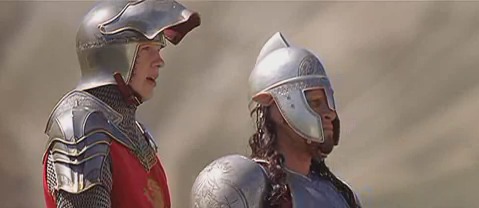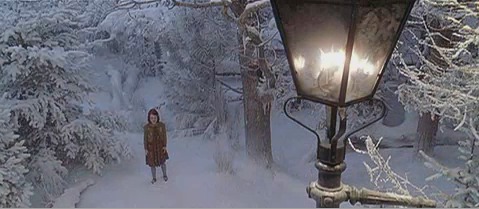The Chronicles of Narnia: The Lion, The Witch, and the Wardrobe (Andrew Adamson, 2005)
Given the billions of dollars poured by appreciative audiences into the Harry Potter and Lord of the Rings series, it was inevitable that we would see an adaptation of C.S. Lewis’ Narnia books, starting with The Lion, the Witch and the Wardrobe. Lewis knew and exchanged ideas with Rings author J.R.R. Tolkien, and The Lion, The Witch, and the Wardrobe has much in common with Tolkien’s novel. For Disney, the studio behind the new film, the appeal would have been irresistible: Lord of the Rings for the Harry Potter demographic, with a series of seven novels to be adapted if the first did well.
While in print the younger focus of The Lion, The Witch and the Wardrobe is obvious purely from its language, on screen the principle difference between the series is that Lewis’ protagonists are four children from our own world: siblings Peter, Susan, Edmund and Lucy (played by William Moseley, Anna Popplewell, Skandar Keynes and Georgie Henley, respectively). Having been sent from London during the blitz, the children are housed in a large, near-empty mansion owned by an enigmatic professor (the always charismatic Jim Broadbent). During a game of hide-and-seek they discover a doorway into the land of Narnia, a world of talking animals and mythological creatures which has been placed into perpetual winter by the evil White Witch (a creepy Tilda Swinton). Reluctantly, the children embrace their apparent destiny: to fight alongside the mighty lion Aslan against the White Witch, so that they can take up the rule of Narnia themselves.
Much has been made of the Christian allegory that Lewis built into the story, with Aslan as the Jesus figure. While it’s pretty evident, it’s also entirely inconsequential to the merits of the story. Allegory, with its paper thin A = B dramatic logic, is the dullest of literary genres, and that’s not the level at which Lewis’ stories have been loved. They’re enjoyed as fantasy, and Andrew Adamson’s film is rightfully respectful of its source. Narnia fans will be happy with the faithfulness of the adaptation: the simple narrative through-line of the book means that it can be readily adapted to film, with Adamson and his co-scriptwriters having the luxury of being able to add incident – notably, an action sequence midway through – rather than taking material out.
The film works best in its earliest passages, capturing the magical wonder of exploration as the children discover Narnia. Georgie Henley is particularly charming as Lucy, the youngest child, and the film is ironically at its most beautiful in the scenes in the bewitched wood. The children befriend several creatures in the forest, all portrayed with charm: the faun Mr Tumnus (James McAvoy, who is excellent and not in the film nearly long enough), and Mr & Mrs Beaver (computer animated characters, voiced by Ray Winstone and Dawn French). Yet in the second half, as it tries to gear up into action mode, the material and its treatment start to feel awkwardly mismatched. Firstly, the novel lacks the scope to warrant the epic treatment Adamson gives it: it seems like the children have been in Narnia for barely an afternoon, so it just feels silly when they are suddenly commanding armies to save the world. And secondly, while Lewis can safely stage an epic battle on the page, on screen it is harder to shoehorn the carnage into the framework of a children’s story. The staging of the final battle is right out of Return of the King, but Adamson can’t cut lose as Peter Jackson could. The tone of the film – so crucial in a fantasy – starts to waver awkwardly, as the sense of children’s fantasy in the first half gives way to a more adult epic in the second. When the distractingly young Peter takes up arms in the final battle, it just doesn’t feel right.
 Part of this comes down to a lack of directorial aplomb. Andrew Adamson probably looked like the perfect director for the material: Disney would have wanted a blockbuster with broad appeal, and Adamson’s work on the Shrek pictures would superficially have shown the sort of demographic flexibility that they would have been after. Yet the key to Shrek films was irreverence, and there’s no room for that in a tale as earnest as this. Stripped of his Tex Avery-inspired digs at his own subject matter, Adamson reveals himself as a fairly prosaic director: the film is pretty to look at, and capably done, but it lacks the flair and risk-taking that Jackson brought to his trilogy. The other attraction of Adamson’s Shrek background was his experience with computer animation, given that several of the characters in this film are fully (or nearly fully, in the case of Aslan) computer animated. Yet nobody seems to have actually looked at the quality of animation in the Shrek films, which was never terribly strong. The bar is much higher when animated characters have to coexist with live actors, and the realisation of the computer animated characters here is at times conspicuously weak. The beavers get by largely on strong voice work, but other characters and creatures are noticeably poorly animated, often looking either fake or overly emphatic in their performances.
Part of this comes down to a lack of directorial aplomb. Andrew Adamson probably looked like the perfect director for the material: Disney would have wanted a blockbuster with broad appeal, and Adamson’s work on the Shrek pictures would superficially have shown the sort of demographic flexibility that they would have been after. Yet the key to Shrek films was irreverence, and there’s no room for that in a tale as earnest as this. Stripped of his Tex Avery-inspired digs at his own subject matter, Adamson reveals himself as a fairly prosaic director: the film is pretty to look at, and capably done, but it lacks the flair and risk-taking that Jackson brought to his trilogy. The other attraction of Adamson’s Shrek background was his experience with computer animation, given that several of the characters in this film are fully (or nearly fully, in the case of Aslan) computer animated. Yet nobody seems to have actually looked at the quality of animation in the Shrek films, which was never terribly strong. The bar is much higher when animated characters have to coexist with live actors, and the realisation of the computer animated characters here is at times conspicuously weak. The beavers get by largely on strong voice work, but other characters and creatures are noticeably poorly animated, often looking either fake or overly emphatic in their performances.
The film’s faithfulness to its source means that it takes on some of Lewis’ more eccentric ideas, such as a cameo by Father Christmas. This scene is a reminder of just how young the original novel was pitched, and most of the problems with the film result from trying to stretch this into an all-ages entertainment. Yet the strength of the material is enough to get The Lion, the Witch, and the Wardrobe across the line. Adamson’s softly-softly approach means that he doesn’t achieve the excellence that Jackson did with his Tolkien adaptation, but he doesn’t mess it up either. As a visualisation of a much-loved classic, the film can barely be faulted, and as an entertainment for children it is similarly successful. But don’t go in expecting it to be another Lord of the Rings: this is not that kind of experience.
This review first appeared at In Film Australia.
